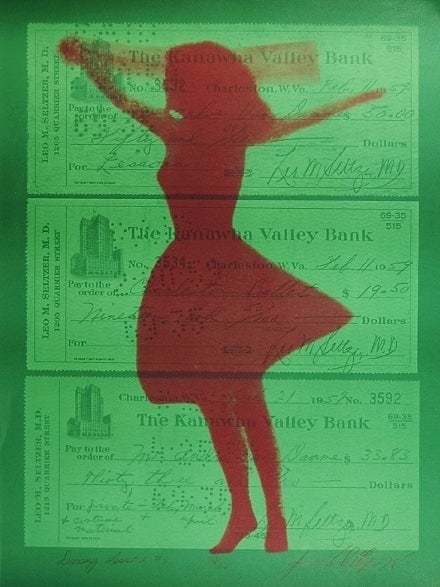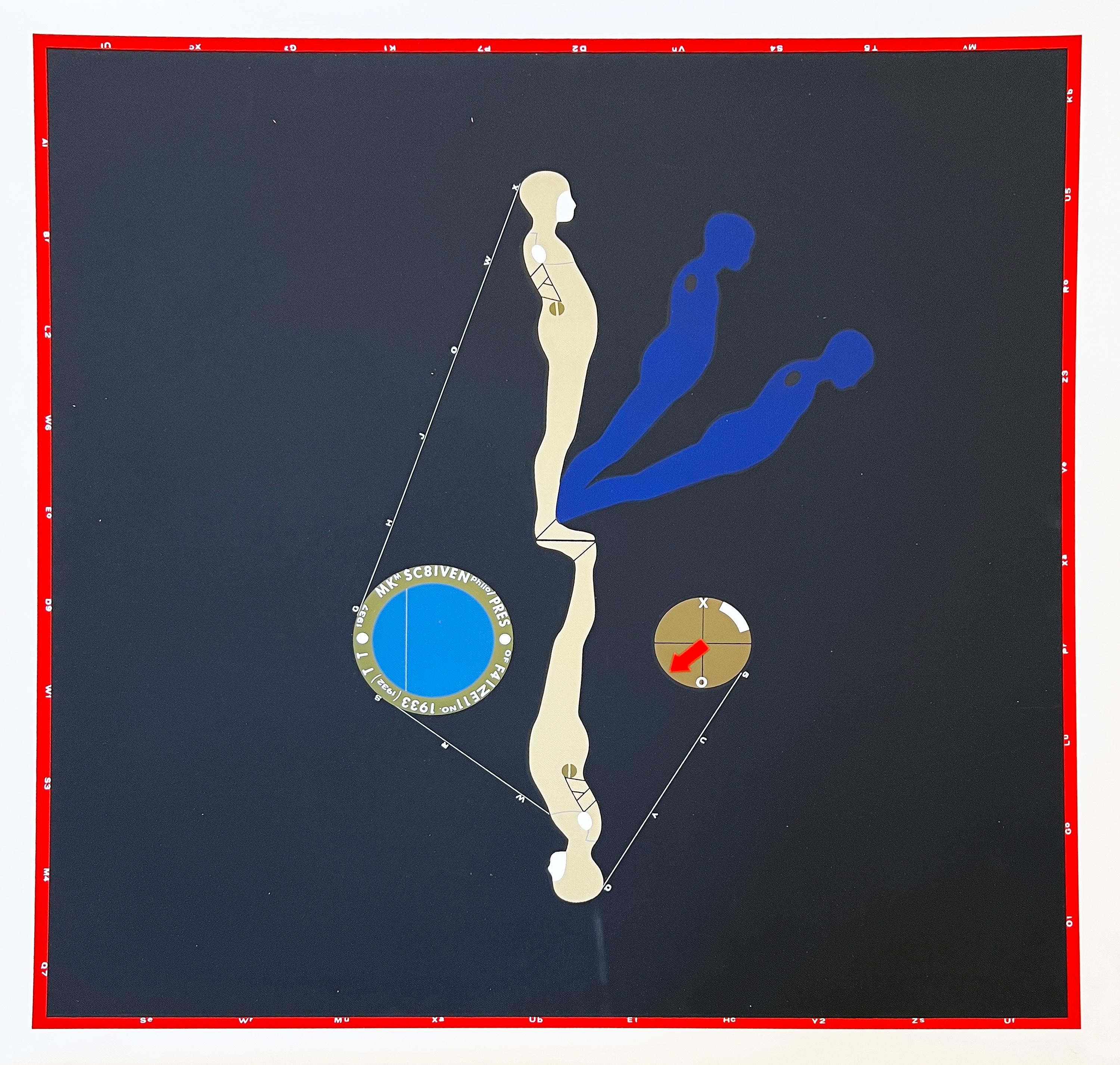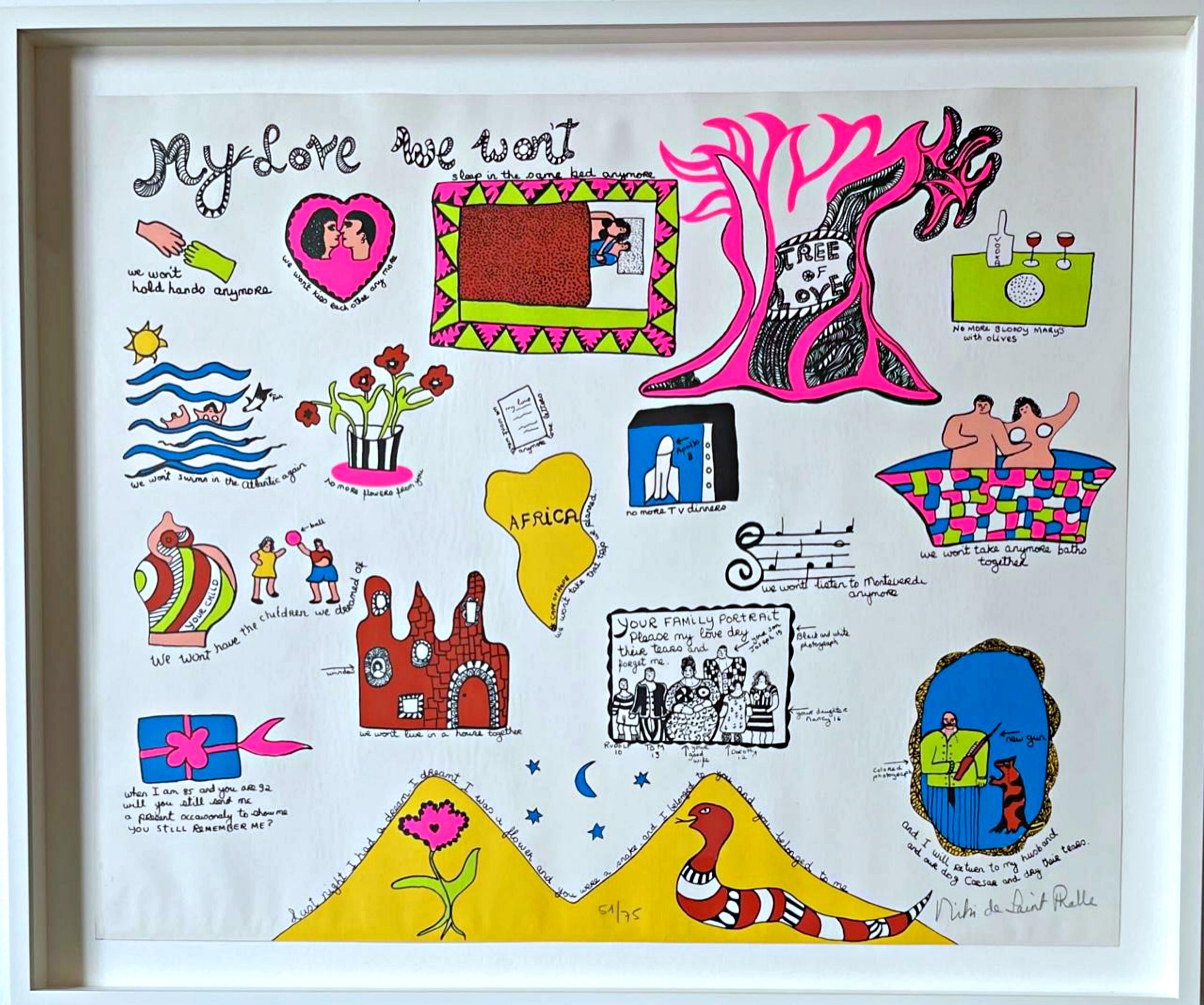Niki de Saint PhalleInvitation au Musee, original museum poster1993
1993
About the Item
- Creator:Niki de Saint Phalle (1930-2002, French, American)
- Creation Year:1993
- Dimensions:Height: 16 in (40.64 cm)Width: 24 in (60.96 cm)
- Medium:
- Movement & Style:
- Period:
- Condition:
- Gallery Location:New York, NY
- Reference Number:1stDibs: LU1745214257562
Niki de Saint Phalle
Niki de Saint Phalle’s art is eclectic and complicated, brave and outspoken. It reveals the unbridled ruminations and opinions of her multifaceted past and transforms them into celebrations of love, life and pure happiness. This transformation reminds us that her work does not simply stand alone, it becomes part of a larger dialogue she created for us to enjoy.
A self-taught sculptor, painter and filmmaker, Saint Phalle made a mark on art history that continues to have an extraordinary dimension. Her work is represented in numerous museums and public collections around the world. In 2000, she received the Praemium Imperiale in Japan, the equivalent of the Nobel Prize for the art world. In 2014, the Grand Palais in Paris exhibited a major restropective of her work that traveled to the Guggenheim Museum in Bilbao, where it currently resides. Saint Phalle died at the age of 71 in La Jolla, California, in 2002.
Find Niki de Saint Phalle art on 1stDibs.
- ShippingRetrieving quote...Ships From: New York, NY
- Return PolicyA return for this item may be initiated within 1 day of delivery.
- Clothes 2By Menashe KadishmanLocated in New York, NYMenashe Kadishman Clothes 2, 1973 Silkscreen on wove paper Signed and numbered 31/70 on the front 23 1/4 × 32 1/2 inches Edition 31/70 Chris Prater of Kelpra Studio, Kentish Town, En...Category
1970s Modern Abstract Prints
MaterialsScreen
- My Love We Wont - coveted, whimsical 1960s silkscreen by beloved female artistBy Niki de Saint PhalleLocated in New York, NYNiki de Saint Phalle My Love We Wont, 1968 Lithograph and silkscreen on wove paper Signed and numbered 51/75 in graphite pencil on the front Frame included: elegantly floated and framed in a museum quality white wood frame with UV plexiglass From the Brooklyn Museum, which has an edition of this work in its permanent collection: "Throughout her long and prolific career Niki de Saint Phalle, a former cover model for Life magazine and French Vogue, investigated feminine archetypes and women’s societal roles. Her Nanas, bold, sexy sculptures...Category
1960s Modern Abstract Prints
MaterialsScreen, Mixed Media, Lithograph, Pencil
- Do You Know...?, from the New York Collection for Stockholm portfolio (Signed/N)By Nam June PaikLocated in New York, NYNam June Paik Do You Know...?, from the New York Collection for Stockholm portfolio, 1973 Silkscreen on paper, in original portfolio sleeve Signed and dated '73 and numbered 36/300 i...Category
1970s Modern Figurative Prints
MaterialsScreen, Pencil
- Rainbow Signed 1970s silkscreen & lithograph by pioneering female Fluxus artistBy Mary BauermeisterLocated in New York, NYMary Bauermeister Rainbow, 1973 Lithograph and silkscreen on creamy white paper Hand signed, dated and numbered 56/250 by the artist on the front 19 x 25.5 inches Unframed This work is on the permanent collection of various institutions like: Rice University, Samuel Dorksy Museum of Art, Rutgers Zimmerli Museum and Wheaton College Massachusetts. While studying the fringe sciences the 1970s, Bauermeister created Rainbow (1973), a lithograph and silkscreen. She uses a creamy white background as the base. Two intersecting diagonal bands of color transcend across the page, and black cursive lettering dances over the surface serving as a mind map of interweaving ideas. Through the central band, Bauermeister shifts through the color spectrum; she begins with red and finishes with violet. Inspired by music, she uses strokes of color that are rhythmically smeared across the lithograph. The surface lettering, a kind of visual poetry, explores her interest in human emotion and science. The viewer can see Bauermeister’s thoughts as they flow into one another through the use of words such as bliss, love, and healing. Bauermeister also includes a repetition of words such as cancer, sickness, and cure. The word cancer emerges from a cell-like shape. A careful study of the words shows that they may seem dark in nature; however, she juxtaposes these words against the cheerful title and colors. Perhaps the rainbow symbolizes a new hope, an inspiration for an optimistic future. -Courtesy to the Samuel Dorsky Museum of Art About Mary Bauermeister: A multidisciplinary artist known for her intricate and enigmatic assemblages, Mary Bauermeister (1934-2023) continues to defy categorization with layered works in a range of media. A precursory figure of the Fluxus movement—her studio was the meeting point for a number of defining artists of the avant-garde—her work plays an integral role in the discussion of art, both European and American, that emerged from the 1960s. Her reliefs and sculptures, which have incorporated drawing, text, found objects, natural materials and fabric, reference a plethora of concepts: from natural phenomena and astronomy to mathematics and language, as well as her own “spiritual-metaphysical experiences.” Maturing amidst the currents of Minimalism and Pop Art, Bauermeister’s art has resisted labels due to the singular expression of her interests and concerns, among them the simultaneous transience and permanence of the natural world with experimentations in transparency and magnification, multiplication and variation, structure and order, chance and ephemerality, introversion and extroversion. Her three-dimensional receptacles of thoughts, ideas, and notes contain visual, conceptual, and philosophical paradoxes that challenge perceptions and that offer literal and metaphorical windows into which one can glimpse the inner workings of the artist’s mind. - Courtesy of Michael Rosenfeld...Category
1970s Modern Abstract Prints
MaterialsLithograph, Screen, Mixed Media, Pencil, Graphite
- Note DBy Grisha BruskinLocated in New York, NYGrisha Bruskin Note D, 1991 Color silkscreen on Somerset paper 34 × 27 inches Edition 74/75 Boldly signed and numbered on front in graphite pencil. Published by Marlborough Graphics Unframed From Russian-American Jewish artist Grisha Bruskin's "Notes" series. In Russia, Bruskin had been accused of creating “subversive” Soviet art and “Jewish propaganda". But he's said, “We have no prejudice here. Even Russians can feel something for art. Some Russians understand the Jewish paintings and some stupid Jewish people do not. It depends upon the person.” Below is an excerpt from a 1988 New York Times profile on Bruskin: “It is my intention to create two lines of mythology based on the mentality of socialism and Judaism,” he solemnly declares, while acknowledging the “difficulty of looking at Soviet art with Western criteria.” Bruskin’s paintings of Jewish characters are equally perplexing to some Soviets, though their meaning is not as evident because he has invented his own symbols. “In Egyptian or Assyrian art, there were symbolic equivalents of beliefs, but not in Judaism,” he says. “I was interested in creating them not at a secular level but at an artistic level.” In his Jewish-themed works, gnome-like characters may appear upside-down, carrying an angel, a menorah or a strange beast. Snippets of Hebrew text...Category
1980s Modern Abstract Prints
MaterialsScreen
- Untitled, from the Album International 2 PortfolioBy Lucienne BlochLocated in New York, NYLucienne Bloch Untitled, from the Album International 2 Portfolio, 1977 Silkscreen on wove paper 11 1/2 × 11 inches Edition 1/50 Hand signed, number and dated on the front Unframed This is a rare Bloch silkscreen, signed and numbered in pencil from the limited edition of only 50. Superb provenance as it is was acquired from the original Album International Portfolio, number 1 of 50. Text from the Colophon page reads as follows: Swiss born, living in California. Limited signed edition of 50 serigraphs by Lucienne Bloch Lucienne Bloch was the daughter of famous European music composer...Category
1970s Modern Abstract Prints
MaterialsScreen
- Indian with Bow in Fox Costume, 1930s Modernist Print by Hilaire HilerBy Hilaire HilerLocated in Denver, CO'Indian with Bow in Fox Costume' is a vintage 1934 WPA era modernist color serigraph/silkscreen print by New Mexico artist, Hilaire Hiler (1898-1966) depicting a Native American figure with stylized feather headdress and Bow in black and red with white. Pencil signed by the artist in the lower right margin. Presented in a custom frame with all archival materials and UV protectant glass, outer dimensions measure 17 ½ x 15 x 1 ½ inches. Image size is 10 x 7 inches (sight). Expedited and International shipping is available - please contact us for a quote. About the Artist: Hilaire Hiler was born in St. Paul, Minnesota, and was raised in Providence, Rhode Island. Hiler took art classes as a child at the Rhode Island School of Design. When he was older, Hiler studied at the Pennsylvania Academy of the Fine Arts, the Pennsylvania School of Industrial Art, Wharton School of Finance and Commerce, and William Server's studio. He also studied at the University of Pennsylvania, the University of Denver, Golden State University, and National College in Ontario, Canada. He continued on to France, studying at the University of Paris in 1919. Hiler lived in Paris from 1919-1934, supporting himself as a jazz musician and a piano player for The Jockey Club. Hiler moved back to America in 1934, settling in San Francisco. He was commissioned by the Works Progress Administration (WPA) to paint murals in the Aquatic Park...Category
1930s American Modern Abstract Prints
MaterialsScreen
- 1970s Pop Art "Dancing Lessons #2" Green, Pink Silkscreen Mod Ballet Girl PrintBy Joanne SeltzerLocated in Surfside, FLthere is a companion piece on a silver paper. A depiction of a ballet dancer, superimposed upon canceled dance class checks. Joanne Seltzer was born in Philadelphia, Pennsylvania a...Category
1970s American Modern Abstract Prints
MaterialsScreen
- Study/Falling Man (Series I)By Ernest Tino TrovaLocated in Missouri, MOStudy/Falling Man (Series I), 1967 By. Ernest Tino Trova (American, 1927-2009) 24 x 24 inches Wrapped to Foam Core Signed Artist Proof Lower Right Ernest Tino Trova (American, 1927-...Category
1960s American Modern Abstract Prints
MaterialsScreen
- Study/Falling Man (Series II)By Ernest Tino TrovaLocated in Missouri, MOStudy/Falling Man (Series II) By. Ernest Tino Trova (American, 1927-2009) 24 x 24 inches Wrapped to Foam Core Signed Artist Proof Lower Right Ernest Tino Trova (American, 1927-2009)...Category
1960s American Modern Abstract Prints
MaterialsScreen
- Propagation-L, mid century figurative abstract screenprint, 20th century artistBy Takesada MatsutaniLocated in Beachwood, OHTakesada Matsutani (Japanese, b. 1937) Propagation-L, 1971 Screenprint in colors Edition 51/75 28 x 27 inches 28.25 x 27.25 inches, framed Takesada Matsutani is a Japanese avant-ga...Category
1970s Modern Abstract Prints
MaterialsScreen
- "Dodge Rebellion Girls" - 1967 Original Silkscreen on Paper Artists ProofBy Marc Foster GrantLocated in Soquel, CA"Dodge Rebellion Girls" - 1967 Silkscreen on Paper 1967 color silkscreen depicting the Dodge Rebellion Girls by Marc Foster Grant (American, b. 1947). A silhouette of the 'dodge gi...Category
1960s American Modern Figurative Prints
MaterialsPaper, Ink, Screen






